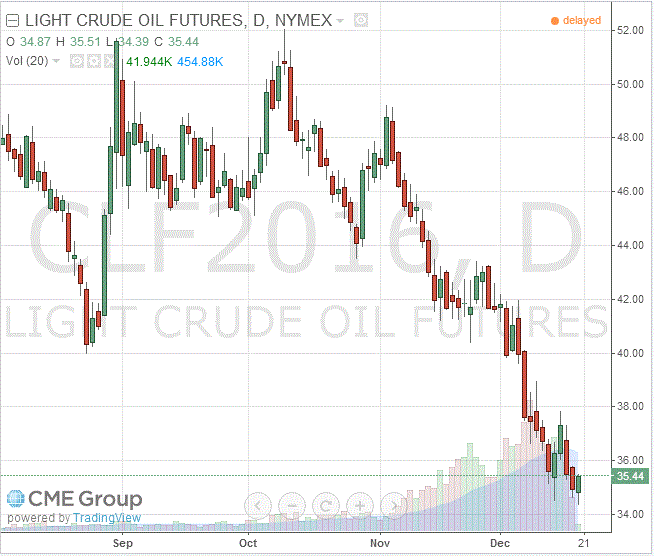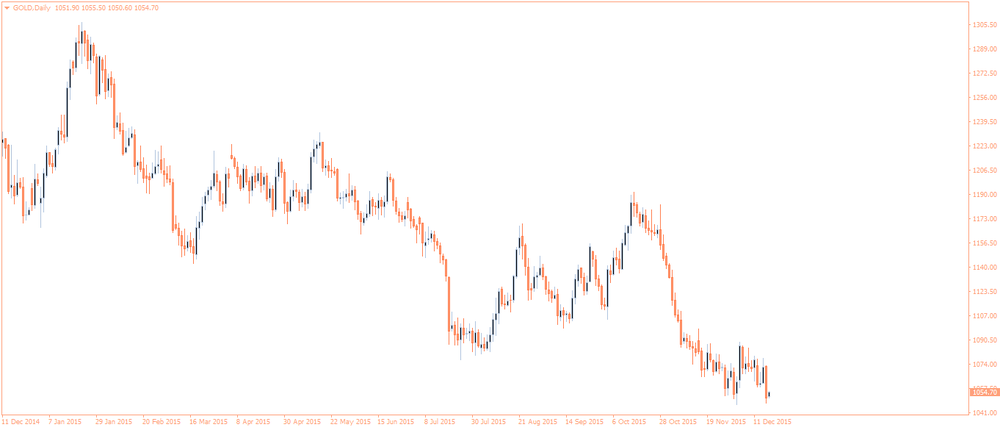Noticias del mercado
-
17:55
Oil prices climb on a weaker U.S. dollar
Oil prices rose on a weaker U.S. dollar.
Gains were limited by concerns over the global oil oversupply. A rise in U.S. crude inventories, Iran's expected comeback to the market and further interest rate hikes by the Fed weigh on oil prices.
News that Russia does not want to cooperate with the Organization of the Petroleum Exporting Countries (OPEC) also weighed on oil prices today.
OPEC said in its World Oil Outlook (WOO) on Friday that it expects oil prices to remain below $100 a barrel in the long-term period.
WTI crude oil for February delivery rose to $35.44 a barrel on the New York Mercantile Exchange.
Brent crude oil for January climbed to $37.58 a barrel on ICE Futures Europe.
-
17:32
Gold recovers yesterday’s losses
Gold price rose on higher demand for safe-haven asset and on a weaker U.S. dollar.
Gains were limited by the Fed's interest rate hike. The Fed on Wednesday raised its interest rate to the range 0.25% - 0.50% from 0.00% - 0.25% as widely expected by analysts.
Gold is traded in U.S. dollars. It suffers when the U.S. dollar strengthens, becoming more expensive for holders of other currencies.
The U.S. services PMI data also supported gold price. Markit Economics released its preliminary services purchasing managers' index (PMI) for the U.S. on Friday. The U.S. preliminary services purchasing managers' index (PMI) dropped to 53.7 in December from 56.1 in November. It was the lowest level since December 2012.
January futures for gold on the COMEX today traded at 1063.00 dollars per ounce.
-
07:27
Oil prices mixed on Friday
West Texas Intermediate futures for January delivery is currently at $36.17 (-0.28%), while Brent crude is at $37.22 (+0.43%). Both crudes are on track to post a third week of declines (-2.2% and -2.1% respectively).
Fundamentals remain bearish. The Energy Information Administration reported on Wednesday that U.S. crude oil inventories unexpectedly rose last week. The Federal Reserve raised its interest rates this week. Higher Fed rates normally support the greenback making the dollar denominated crude more expensive for customers using other currencies. Investors are also waiting for U.S. lawmakers to vote on oil exports ban elimination.
Analysts say that oil prices have not reached the bottom yet.
-
07:10
Gold steadied close to a multi-year low
Gold climbed to $1,054.20 (+0.44%) after a sharp decline in the previous session, but remained not far from a six-year low. On Wednesday the central bank of the U.S. raised its interest rates to a range of 0.25%-0.50% from 0%-0.25%. Higher rates increase the opportunity cost of holding the non-interest paying precious metal and reduce demand for it. Bullion is on track to post a nearly 2% decline this week.
Technical analysts say that the precious metal may test the key $1,000 level soon.
Assets in SPDR Gold Trust, the biggest gold-backed exchange-traded fund in the world, fell 0.70% to 630.17 tonnes on Thursday, the lowest since September 2008.
-
00:35
Commodities. Daily history for Dec 17’2015:
(raw materials / closing price /% change)
Oil 34.83 -0.34%
Gold 1,050.10 +0.05%
-

